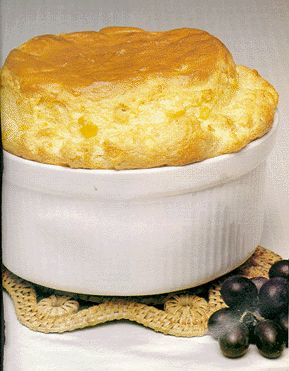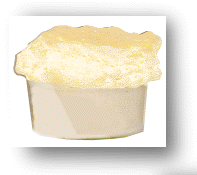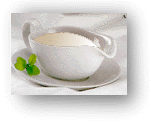
 A SOUFFLE can strike fear in the heart of a new baker. The word is derived from the French souffler, or blow up, describing the action in the oven when the air trapped in egg whites expands in the heat of the oven. Though a souffle apprears as delicate as a cloud, when made properly, it is almost indestructible.
A SOUFFLE can strike fear in the heart of a new baker. The word is derived from the French souffler, or blow up, describing the action in the oven when the air trapped in egg whites expands in the heat of the oven. Though a souffle apprears as delicate as a cloud, when made properly, it is almost indestructible.
Souffles are usually accompanied by a bit of culinary theater as they are raced from oven to table. An oversized serving spoon makes the first break, and poof! the domed top slowly falls back into the baking dish. What ends up on your plate is a portion of baked whipped eggs in a bit of sauce. It is a light and graceful, as well as impressive, addition to a meal.
View the preparation as two parts. First, make a base of egg yolks and flavoring. Then beat the eggs whites and fold in carefully. The hardest part is seperating the eggs. I use the method where the egg is cracked in half and the yolk is passed back and forth between the half shells; the white falls into a bowl. Cream of tartar is added to the whites to help them thicken properly during whipping.
Use a souffle dish or a Charlotte mold, (slanted sides just won't do). While recipes call for a collar on the dish, I never use one unless my uncooked mixture is closer than one inch to the top.
Your finished souffle will directly reflect the oven temperature. If it is flat when baked, your temperature was too low. If crusty and dark outside and raw in the center, the temperature was too high. Make sure it is always placed in the center of the oven and don't peek; even the slightest change in temperature will affect the rising.
The savory version is my favorite. Use any cheese like Gruyere, Swiss, Cheddar, Montrachet (if you use a soft goat cheese, stir it into the base), or even SoyaKaas tofu cheese.
The dessert version is from one of my favorite Bay Area continental restaurants, "La Foret" in the rustic old Almaden section of San Jose.
| 3 1/2 tablespoons butter 4 tablespoons all-porpose flour (sifted) 1 1/2 cups milk 6 egg yolks 1 teaspoon Dijon mustard 1/4 teaspoon freshly grated nutmet Few grinds black pepper pinch of salt 8 egg whites 1/8 teaspoon cream of tartar 1 1/4 cups grated cheese |
Preheat the oven to 400 degrees. Butter the bottom and sides of a 2 quart souffle dish. sprinkle with dry bread crumbs or Parmesan cheese.
Melt the butter in a soucepan over medium heat. Add the flour and stir with a wire whisk until smooth. Add the milk and stir constantly until the mixture boils and thickens. Remove from the heat and stir in the egg yolks, one at a time. Stir in the mustard, nutmeg, pepper and salt.
Combine the egg whites and cream of tartar in a large clean bowl and beat at high speed with an electric mixer until stiff peaks are formed. Using a rubber spatula, add the cheese to the base and gently fold in the whites in three additions; do not overmix. Spoon into the souffle dish.
Reduce the heat to 375 degrees. Bake souffle about 25 minutes and remove when puffy and browned. Serve immediately. Serves 4
| 1 cup milk 1 cup sugar 3 tablespoons all-purpose flour, sifted 2 tablespoons Grand Marnier liqueur 6 large eggs (room temperature), separated 3 tablespoons unsalted butter (room temperature) 1/2 teaspoon cream of tartar Souffle sauce:1/3 cup Grand Marnier1/2 cup heavy cream, slightly warm 1/4 cup sugar 1/2 teaspoon vanilla extract |
 Preheat the oven to 400 degrees. Butter the sides and bottoms of six 6-oz souffle dishes (or 1 1/2 quart Corning dish). Sprinkle with sugar, shaking out the excess. Place dishes on a large baking sheet.
Preheat the oven to 400 degrees. Butter the sides and bottoms of six 6-oz souffle dishes (or 1 1/2 quart Corning dish). Sprinkle with sugar, shaking out the excess. Place dishes on a large baking sheet.
In a heavy, medium-size saucepan, combine the milk, sugar flour and liqueur. Beat vigorously with an immersion blender or balloon wire whisk over medium heat until smooth; bring to a boil. Boil 1 minute, until thick. Over low heat, add the egg yolks, one at a time, beating constantly. Add the butter and whip until very thick, 1 minute.
Remove from the heat and divide the mixture equally between two bowls. Preparation can be done in advance to this point. The custard base may be covered with plastic wrap and stored in the refrigerator. Rewarm the base before proceeding.

To make the souffle sauce, and the liqueur, warm cream, sugar and vanilla to one bowl of base, and whip with the immersion blender or whisk until smooth. Cover with plastic wrap and refrigerate until serving.
Combine the egg whites and cream of tartar in a large clean bowl, and beat at high speed with an electric mixer until stiff, but not dry, peaks are formed. Using a rubber spatula, gently fold the whites into the remaining bowl of base in three additions; do not overmix. Divide the misture among the prepared souffle dishes (or pour into 1 1/2 quart Corning dish).
Reduce the oven temperature to 375 degrees. Place the baking sheet in the center of the oven and bake souffles for 17 minutes, until puffed and golden. To serve, divide the sauce among 6 dessert plates. Run a small spatula around the edge of the souffle and turn out onto the sauce. Serve immediately. Serves 6.